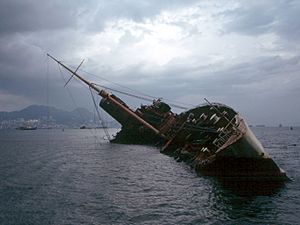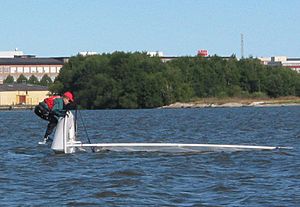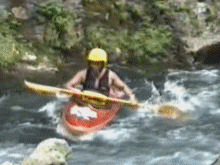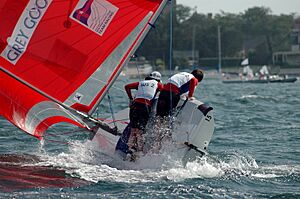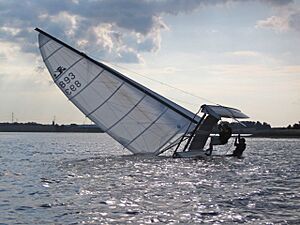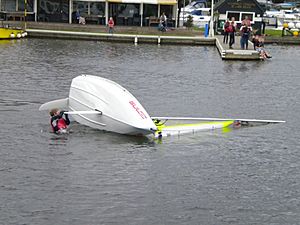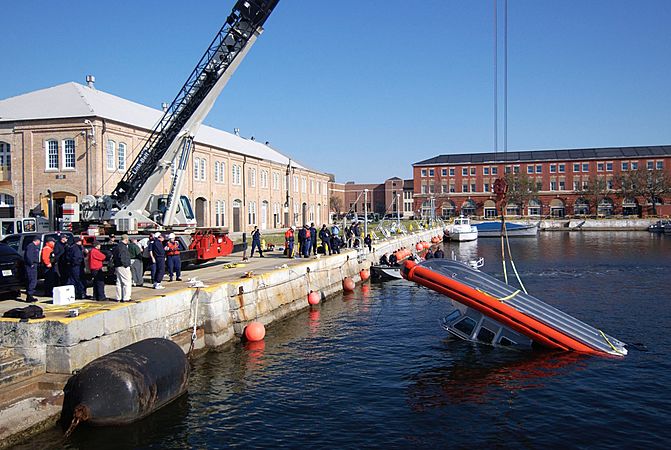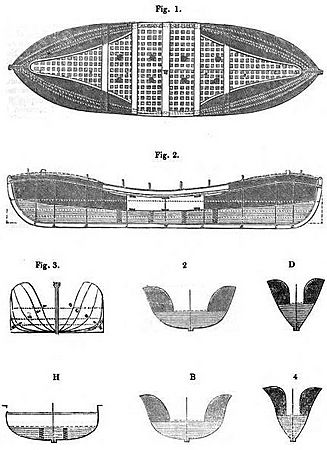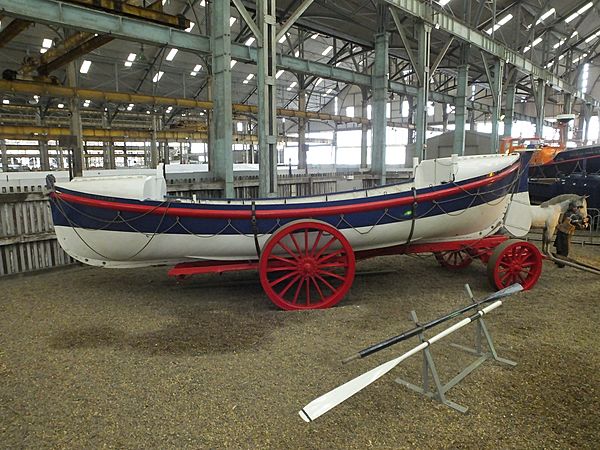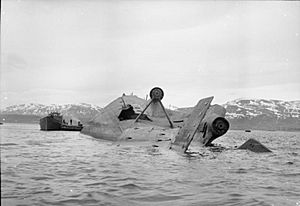Capsizing facts for kids
Capsizing happens when a boat or ship rolls over onto its side, or even completely upside down, in the water. This can be caused by big waves, strong winds, or if the boat becomes unstable. When a boat is upside down, it's often called being "turtled." The act of getting a boat back upright after it has capsized is called righting. Boats might capsize if they turn too fast, lose their balance because cargo moves, or if water gets inside.
If a boat that has capsized can still float, it might be able to turn itself back upright. Some boats are designed to do this on their own; these are called self-righting vessels.
Contents
Small Boats and Capsizing
For small sailboats, like dinghies, there's a difference between being "knocked down" and "turtling." Being knocked down means the boat is on its side, almost at a 90-degree angle. Turtling means it's completely upside down.
Small dinghies often capsize while being used, and the crew can usually get them back upright. Sometimes, sailors even capsize their dinghies on purpose. This can be the quickest way to get water out of the boat.
Capsizing is a normal part of sailing small dinghies. It's not a question of "if" it will happen, but "when." If you don't want to capsize, a keelboat (a boat with a heavy keel at the bottom) is more stable. But even large yachts can capsize in very bad weather. So, it's important that boats are designed for the conditions they will face.
If a kayak capsizes, the paddler can often right it using a special move called a kayak roll. As long as the kayaker knows what to do and the water isn't too shallow or dangerous, capsizing in a kayak is usually not a big problem. In whitewater kayaking, capsizing happens often and is part of the sport. Kayak rolling is even a competitive sport, especially in Greenland.
Boats have a "capsize ratio" which helps show how safe they are for sailing far from shore. A lower number means it's generally safer. However, truly understanding a ship's stability involves looking at many other things like waves, tides, weather, and possible damage.
Large Ships and Capsizing
In a big storm, even large ships can roll over if a huge wave hits them from the side. This is usually very bad for big ships. Smaller yachts might lose their masts and rigging (the ropes and wires that support the mast) because of the pull of the water as the boat rolls.
A ship can also capsize if it gets a hole or crack and water rushes in. This is how torpedoes and naval mines work in warfare. For example, in 2012, the huge cruise ship Costa Concordia hit a rock and started to sink. It rested on its side, but most of it was still out of the water. This was a partial sinking, not a full capsize. Fixing a hole is called "plugging."
Sometimes, a ship that is mostly upright can capsize if too much water gets into areas that are normally above the waterline. This can happen because of bad steering, carrying too much weight (overloading), or rough weather. Water can be removed using a bilge pump or buckets. If a ship has taken on too much water and is close to sinking, it might not be able to become stable again. At this point, people usually decide to abandon the ship.
Some ships, like roll-on-roll-off (RORO) ships, are more likely to capsize. These ships have large open decks for cars near the water. If the watertight doors on these decks fail (like when the doors were accidentally left open on the MS Herald of Free Enterprise), water can flood in. This water can slosh around, making the ship very unstable and causing it to capsize. If vehicles on a RORO ferry are not tied down, they can slide around as the ship rolls. This changes the ship's balance and can make it capsize even faster.
Boat Racing and Capsizing
In competitive yacht racing, a boat that has capsized has special rules because it can't move properly. A boat is considered capsized when its mast touches the water. If it's completely upside down, it's called "turtled." Good racers can often recover from a capsize very quickly.
Capsizing can also happen if a boat turns too sharply, especially if its keel isn't deep enough to keep it upright.
Some rescue lifeboats, like the RNLI's Severn-class, are designed to be self-righting. This means they can turn themselves back upright if they capsize. However, most other motorboats are not built this way.
Learning to Right a Boat
Sailors who are learning are often encouraged to capsize their dinghies on purpose in a safe place, with someone watching. This helps them learn how their boat floats and how to right it. After capsizing, they practice getting the boat upright, bailing out the water, and setting the sails again. This way, if they capsize by accident, they know what to do.
Most small sailboats with one hull can be righted by standing or pulling down on the centreboard or daggerboard. This helps lift the mast out of the water. Once the mast is about 30 degrees from being flat, the boat's design usually helps pull it upright.
Righting a catamaran (a boat with two hulls) that is on its side involves using a special line. The crew stands on the lower hull and pulls on this line. For small catamarans like the Hobie 16, it's important for a crew member to do this quickly. If not, the boat might "turtle" (go completely upside down), which makes it much harder to recover without help. Some boats have a small floating device on top of the mast. This helps prevent the boat from going completely upside down, or at least makes it unstable if it does.
When righting a boat, it helps if a crew member lifts the end of the mast out of the water. The hardest part of righting a capsized boat is getting the water out of the sails. It's also helpful to point the front of the boat towards the wind. This way, when the sail starts to lift, the wind can get underneath it and help push the boat upright.
It's important to be careful not to let the boat swing too far and capsize on the other side. This is more likely to happen if the boat isn't pointed into the wind.
Stopping Capsizing
There are many ways to prevent a boat or ship from capsizing. One way is to use inflatable airbags, also called lift bags. These bags fill with air and increase the boat's buoyancy (its ability to float). Crews can also help prevent capsizing by spreading weight evenly and being careful in windy weather.
Yachts
Yachts can capsize if water gets inside the hull, making them less buoyant. A flotation system can be installed in yachts. This system uses lift bags placed inside the hull. These bags increase the yacht's buoyancy and fill empty spaces where water could collect. This gives valuable time to remove water, fix damage, or leave the boat safely.
Large Ships
When large ships like cargo ships or tankers capsize, it's usually impossible to recover them. It can also cause serious environmental damage if their cargo spills. Newer large ships are being fitted with "Surfacing Systems for Ship Recovery." This is an inflatable device installed in the ballast water tank or inside the hull. It can be deployed very quickly after an accident to stabilize the ship. This gives more time for rescue and evacuation.
Self-Righting Boats
-
A crane capsizes a small coast guard vessel to test its righting ability
A boat is called "self-righting" if it's designed to capsize and then return to an upright position on its own, without anyone helping it. For a self-righting boat, there's no angle where it becomes unstable and stays upside down. It will always come back upright, even from being completely upside down. A self-righting boat must also float well even when it's full of water.
There are three main ways to make a boat self-righting:
- Carefully placing heavy weights low down and buoyant (floating) parts high up.
- Using inflatable airbags.
- Using movable weights.
A simple way to understand a boat's stability is by looking at a "static stability diagram." This chart shows how stable a boat is at different angles of tilt. If the chart shows that the boat is never stable upside down, it means it will self-right.
To make a boat self-right using weight and buoyancy, you need to put heavy things low in the boat and things that float high up. This is often done with a self-sealing top structure, like the large cabins on modern rescue boats.
Most small lifeboats with hard hulls, built since the mid-1900s, are designed to be self-righting. Even some small radio-controlled boats can self-right, which is very useful for racing.
Famous Capsizings
Here are some notable times ships have capsized:
- Mary Rose, July 19, 1545: An English warship that capsized and sank, leading to 380 deaths.
- Vasa, August 10, 1628: A Swedish warship that capsized on its first trip, with 30-50 people dying.
- RMS Empress of Ireland, May 19, 1914: Capsized and sank in the Saint Lawrence River after hitting another ship, with 1,012 deaths.
- SS Eastland, 1915: An excursion boat that capsized, causing 845 deaths, the biggest loss of life on the Great Lakes.
- USS Oklahoma (BB-37), December 7, 1941: A U.S. battleship torpedoed at Pearl Harbor, with 415 missing or killed.
- German battleship Tirpitz, November 12, 1944: Sunk by Royal Air Force bombers, over 1,000 deaths.
- SS Andrea Doria, July 25, 1956: Capsized after hitting another ship, killing 46 people.
- MS Herald of Free Enterprise, March 6, 1987: Capsized because its bow doors were left open, killing 193 passengers.
- MS Estonia, September 28, 1994: Capsized, killing 852 passengers.
- MV Le Joola, September 26, 2002: A Senegalese ferry that capsized, with at least 1,863 deaths.
- Costa Concordia, January 13, 2012: Ran aground off Italy, with about 4,200 people aboard; most were saved, but 27 died.
- Sewol, April 16, 2014: Capsized off South Korea, with over 450 people on board; 304 died.
- Dongfang Zhi Xing, June 1, 2015: A large vessel that capsized and sank on the Yangtze River during a thunderstorm, with 442 deaths.
- MV Phoenix, July 5, 2018: Capsized in a sudden storm near Phuket, Thailand, resulting in 41 deaths.
- MV Nyerere, September 20, 2018: A ferry on Lake Victoria, Tanzania, capsized due to overloading and a sharp turn, killing 227 people.
See also
 In Spanish: Zozobrar para niños
In Spanish: Zozobrar para niños
- Glossary of nautical terms
- keeling over
- Limit of positive stability
- Seakeeping, also called Seaworthiness
- Seamanship
- Turtling (sailing) – a full capsize where the mast and sail are completely underwater.
Images for kids


